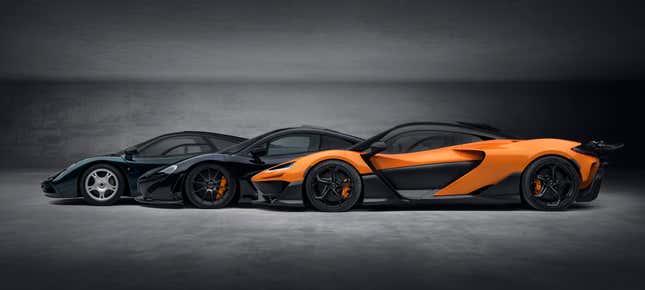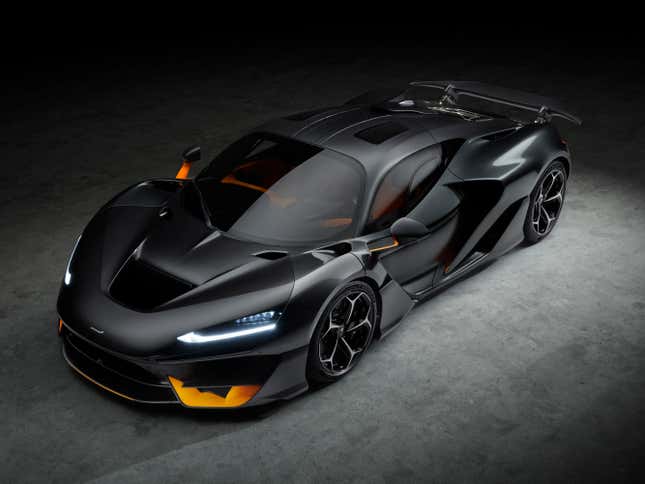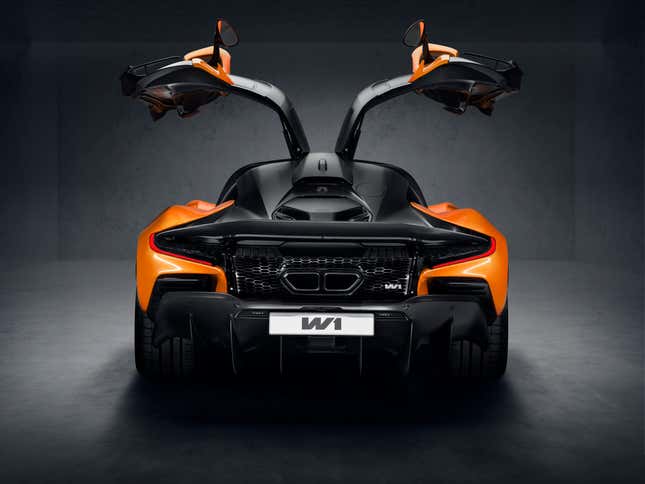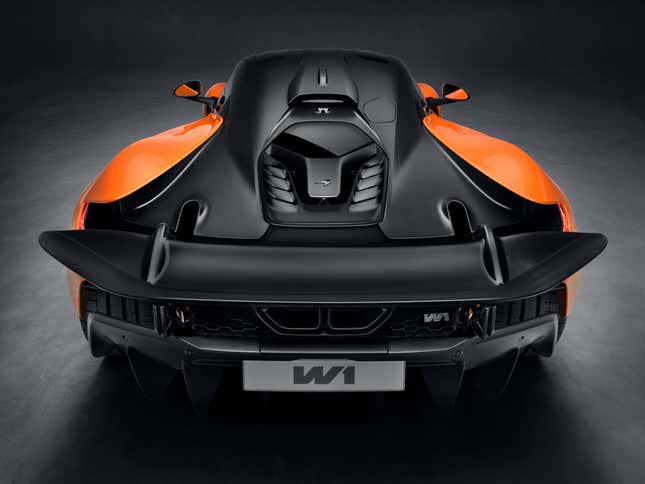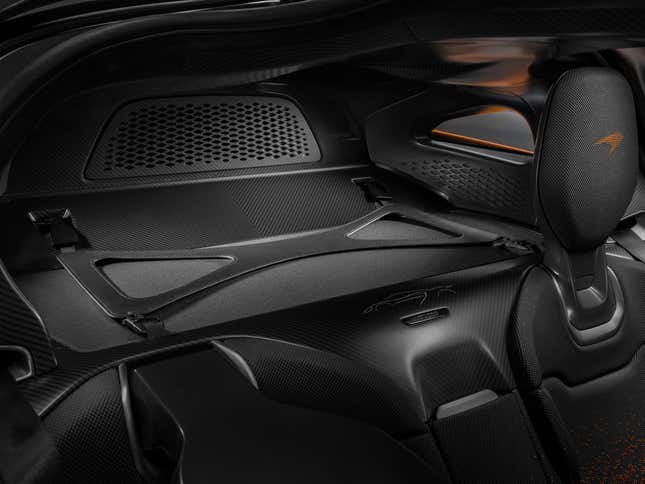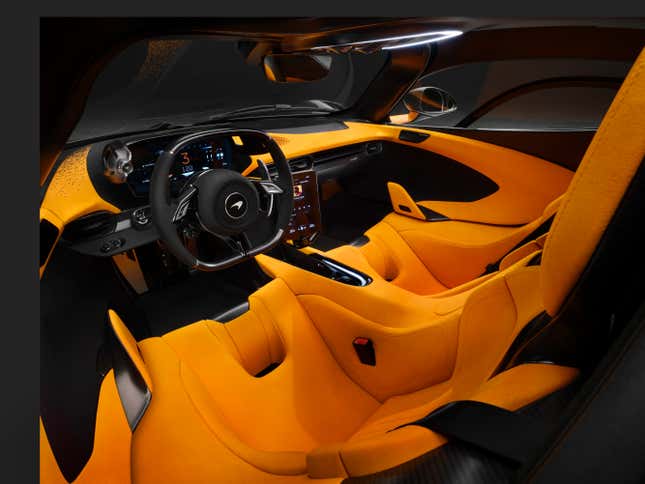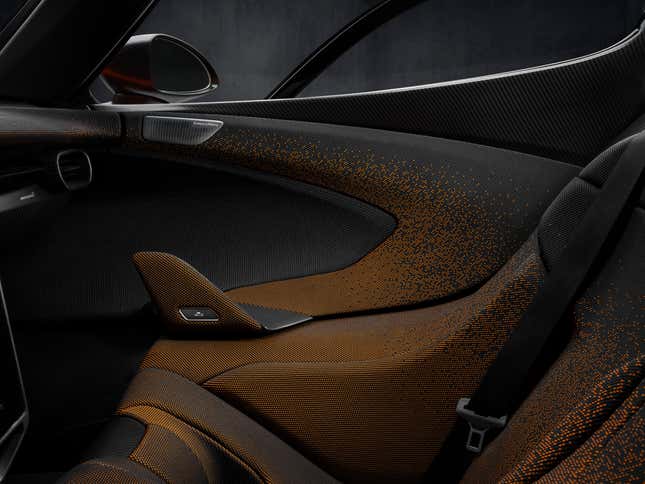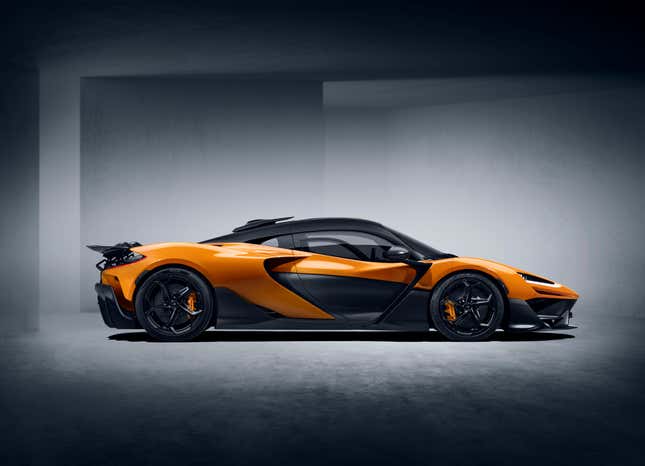We’re midway by way of a brand new decade, which implies it’s time for a brand new McLaren hypercar. Enter the W1, the plug-in-hybrid successor to the beloved P1. “Equally at dwelling on street and monitor,” the W1 is the quickest McLaren street automobile each in a straight line and on monitor, and together with a model new chassis and powertrain, it options a few of the coolest aerodynamic trickery we’ve seen.
All of it begins with the Aerocell, a very new carbon-fiber monocoque that’s McLaren’s lightest but. Sometimes reserved for race automobiles, the Aerocell is created from carbon fiber that’s pre-impregnated with a resin that simplifies the curing course of and a strain therapy that’s utilized within the mould, making the construction lighter and stronger. The Aerocell’s ground is 2.6 inches increased to permit for many trick aero and lower-front suspension mountings which are built-in straight into the construction, and no subframe is required.
The center of the W1 is a plug-in-hybrid powertrain that makes use of a model new twin-turbocharged 4.0-liter V8 dubbed the MHP-8. This flat-plane-crank motor makes 915 horsepower and 664 pound-feet of torque by itself, and it revs all the way in which as much as 9,200 rpm, the very best of any McLaren, achieved by utilizing plasma spray coated cylinder bores. It additionally has the very best particular output of any McLaren at 230 hp per liter, and the turbos have increased peak energy and improved response, coming in at 2,500 rpm. To verify the W1 sounds improbable, the enormous twin exhaust suggestions that exit from the middle of the rear finish have tubular manifolds and lengthy equal-length runners.
Mounted to the facet of the W1’s new eight-speed dual-clutch transmission is a radial flux electrical motor and motor management unit in an identical setup to what IndyCar makes use of, and the entire unit weighs solely 44 kilos. The motor makes 342 horsepower, about double what the P1’s electrical motor produced, and it could actually spin at as much as 24,000 rpm. It’s fed power by a 1.4-kWh battery pack housed as little as doable in a cavity of the monocoque’s ground. As a complete, the W1’s hybrid system is 88 kilos lighter than that of the P1, however with double the ability. Complete output from the powertrain is 1,258 hp and 988 lb-ft. There are ten complete warmth exchangers and three separate water cooling circuits that run at completely different temperatures, considered one of which is devoted to the hybrid system, and a separate oil-to-air radiator for cooling the transmission.
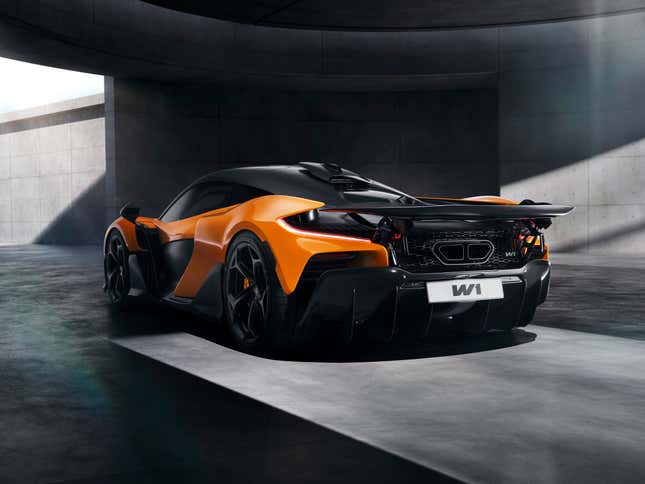
McLaren says the W1 will hit 60 mph in 2.7 seconds, which is rattling fast for a purely rear-wheel-drive automobile. The W1 reaches 124 mph in 5.8 seconds, and hitting 186 mph takes lower than 12.7 seconds, nearly 4 seconds faster than the P1. High pace is proscribed to 217 mph. As for electric-only operation, there’s not a lot of it. McLaren says it may be pushed in pure electrical mode for simply 1.6 miles, and the battery at all times holds a minimal state of cost essential to crank the engine and for the reverse, which is completed solely utilizing the electrical motor. Recharging takes 22 minutes.
Bringing the W1 down from these speeds is an evolution of McLaren’s hydraulic brake system. The carbon-ceramic discs measure 15.4 inches at each axles, with six-piston calipers up entrance and four-piston calipers on the rear, and the digital parking brake is built-in within the rear calipers, which improves stiffness. “Wheel aerodynamic appendages” are impressed by System 1 cooling ducts to extend downforce, and the brake strains are re-routed for higher air circulate beneath the automobile. McLaren says it takes simply 95 ft for the W1 to cease from 62 mph and 328 ft to cease from 124 mph, each about the identical as the Senna. Three completely different Pirelli tires can be found, all sized 265/35ZR19 up entrance and 335/30ZR20 within the rear. The usual tire is the P Zero Trofeo RS, with a specifically developed compound for monitor efficiency, however you can too spec less-extreme P Zero R or P Zero Winter 2 tires.
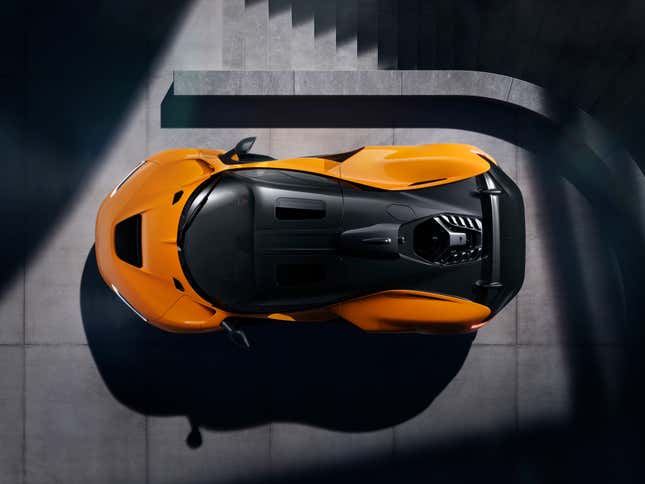
The W1 has a dry weight of three,084 kilos, solely 9 kilos greater than the P1 and tons of of kilos lighter than PHEV supercars just like the Ferrari 296 GTB and McLaren Artura. It’s the primary McLaren with pushrods that hyperlink to inboard dampers up entrance, and heave dampers, torsion bars and wishbones like on F1 automobiles. The rear suspension makes use of conventional outboard springs as airflow isn’t as large of a priority, and the titanium entrance uprights and wishbones are 3D printed.
However it’s the W1’s aerodynamics which are the star of the present, dictating every little thing about how the automobile seems. McLaren says its engineers spent at the least 350 hours within the wind tunnel testing 5,000 factors, they usually ran over 3,000 computational fluid dynamics simulations. Its styling isn’t tremendous groundbreaking on face worth, a mixture of components from automobiles just like the P1, Elva and Senna, however I feel the W1 seems fairly sick general, and the extra you begin poring over the small print the extra cool belongings you discover. The 2-tone scheme is impressed by McLaren’s F1 automobiles, and it does a terrific job of displaying off how the air flows across the automobile — on this launch spec the extra complicated aero components are completed in carbon fiber, whereas the properly sculpted bodywork is painted.
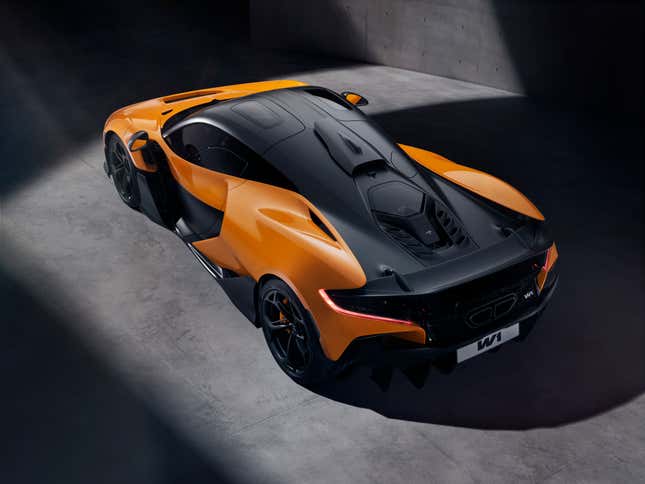
There are a selection of enormous intakes within the entrance bumper, with a entrance wing actuated by two electrical motors, swinging in an arc to ship air underneath the automobile by way of an F1-style T-tray and keel. The middle part feeds air to the keel, and the outer areas generate downforce. That entrance wing can deploy to infer downforce when braking, too. Behind the massive hood consumption is an aero blade that lifts for entry to the charging port and reservoirs for the brake and washer fluid.
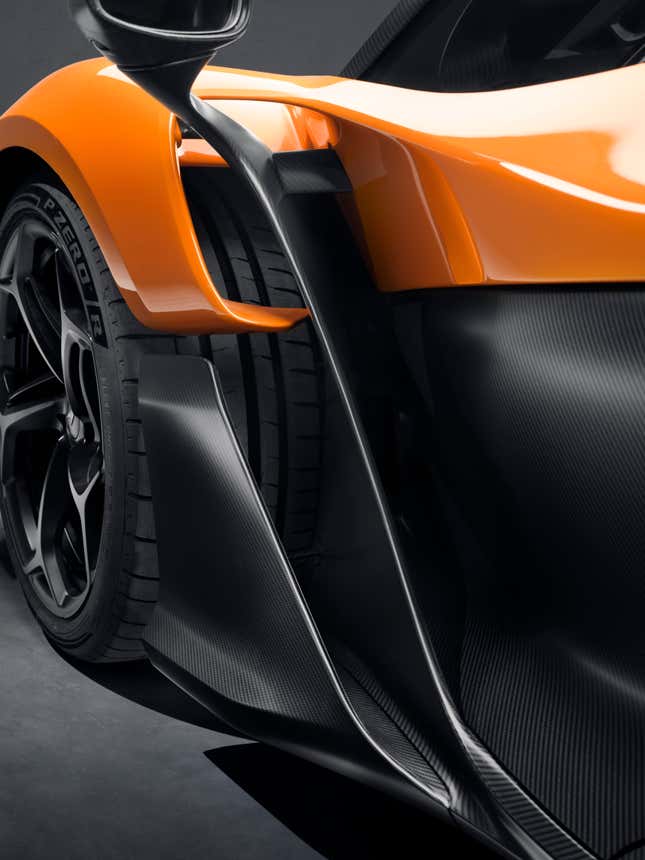
You possibly can see the entrance suspension arms by way of the complicated fenders and entrance wheel arches, which have a blade component that flows into the facet mirrors which are positioned as outboard as doable and direct air away from the rear. Giant intakes forward of the rear wheels are impressed by F1 facet pods, and the form echoes the McLaren boomerang brand from a number of viewing angles. Inside these large pods are the triangular high-temperature radiators, whereas a decrease consumption forward of the rear wheels channel air to the brakes and diffuser. The one element created from composite as an alternative of carbon fiber is the circulate diverter that sits above the engine cowl and homes the shark fin antenna, beneath which is the CHMSL and rear-view digital camera.
The W1 has McLaren’s most excessive diffuser but, curving upward from simply behind the cabin forward of the rear axle, and it’s “shrink-wrapped” to the powertrain. To attain this diffuser measurement and form, the engine is inclined by three levels and the radiators and suspension wishbones had been raised. The diffuser is created from intermediate modulus carbon fiber, one other first for McLaren, and there’s no want for a cross-car construction linking the suspension pick-up factors because the diffuser is so sturdy and stuff. It is also a part of the crash construction, performing because the automobile’s rear bumper like on the Bugatti Tourbillon.
By far the wildest a part of the W1’s aerodynamic package deal is the Lively Lengthy Tail wing that sits above the rear bodywork. Powered by 4 electrical motors and 6 actuators, the wing can lengthen as much as 11.8 inches rearward, and it could actually additionally transfer up or down with adjustable pitch. Moreover, the wing has a DRS perform and in addition acts as an airbrake at excessive speeds. It seems actually spectacular when totally prolonged, and the taillights wrap across the floating haunches that comply with the profile of the wing. Right here’s what McLaren says concerning the Lively Lengthy Tail:
The Lively Lengthy Tail wing is aided by a roof-mounted circulate diverter machine that controls air to the rear of the automobile, conserving it linked to the rear deck and wing. This enables the Lively Lengthy Tail wing to work at a decrease peak, lowering aerodynamic drag and, in Race mode, to increase the diffuser impact. On this mode it strikes 11.8in rearwards by way of a 180-degree arc; on this place the wing vanguard sits behind the diffuser trailing edge successfully turning into an extension of the underbody. The additional benefit relative to a traditional excessive mounted wing is that as an alternative of the rear bodywork being lifted by the wing’s suction impact, it’s now being pushed down as a consequence of stagnation of the air on the higher floor of the wing. One other first for a McLaren automobile is using E-motors on the energetic entrance and rear wings, with six actuators permitting a larger diploma of accuracy and pace of motion. Comprised of two components to maximise general curvature, the Lively Lengthy Tail wing’s helps have been aerodynamically profiled and every incorporates a slot hole to enhance efficiency in crosswinds.
The entrance wing and Lively Lengthy Tail rear wing are tuned to consistently modify in line with the driving force’s steering, accelerating and braking inputs and the car’s pace. Beneath straight line acceleration the Lively Lengthy Tail wing will tilt to scale back drag, whereas the entrance wing will trim accordingly to optimize car steadiness with out compromising on steering really feel or the circulate of air for brake and powertrain cooling. Beneath braking, the Lively Lengthy Tail acts as an airbrake whereas the entrance wing swings as much as considerably cut back pitch sensitivity. In cornering conditions each wings will set to their optimum place to steadiness downforce in line with the car pace.
In Race mode the W1’s journey peak lowers by 1.46 inches up entrance and 0.7 inches within the rear, and it presents two suspension stiffness settings. Complete downforce is available in at 2,205 kilos at 174 mph, and the W1 has 20 p.c much less drag than the Senna with its wing in DRS. McLaren says the W1 is quicker round a monitor than any of its street automobiles earlier than it, citing a lap time across the Nardo circuit three seconds quicker than the Senna. A GP mode presents consistency for lengthy trackday classes, whereas Dash mode offers you most efficiency over one lap. There’s additionally a Enhance button that immediately offers you the complete electrical energy out there. For street driving the W1 has Consolation and Sport drive modes; Consolation makes use of the electrical motor only for torque fill, whereas Sport presents full hybrid energy with ignition lower gear shifts.
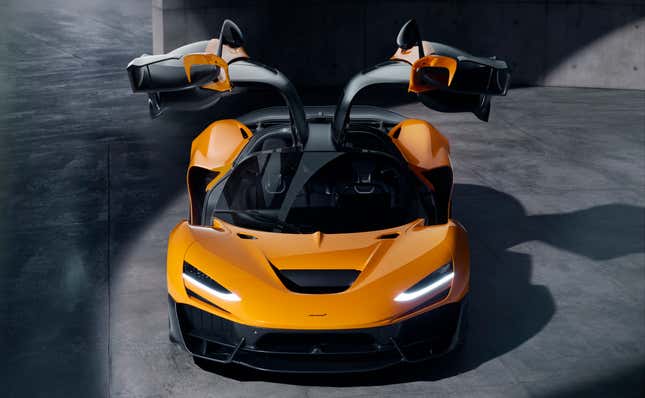
As a substitute of the butterfly doorways utilized by principally each fashionable McLaren, the W1 has “Anhedral” doorways which are principally fancy gullwing items. The form of the doorways present 3.9 inches of additional cooling area for the high-temperature radiators, which allowed the dimensions of the radiators to be lowered, and smaller sills make it simpler to get out and in of than different McLarens. The within of the doorways are sculpted out to maximise area, and there are glass panels within the roof and rear pillars for higher visibility. McLaren says the W1 has its thinnest A-pillars ever, too, and the solar visors are solely 0.1 inch thick.
The seats are mounted, built-in straight onto the Aerocell (saving 2.8 inches of wheelbase), with the steering wheel and pedal field being adjustable, and the footwell is increased up and the driving place extra reclined than typical. Shockingly, the W1 even has a sliding pair of cupholders in a storage cubby between the seats, plus a second storage space behind the armrest. The headrests fold forwards to create a “loading platform” for a storage shelf behind the seats that may maintain 4.1 cubic ft of stuff, like weekend baggage or a pair of racing helmets. Furthering its each day driver skill, the 8-inch touchscreen presents Apple CarPlay and each USB-A and USB-C ports.
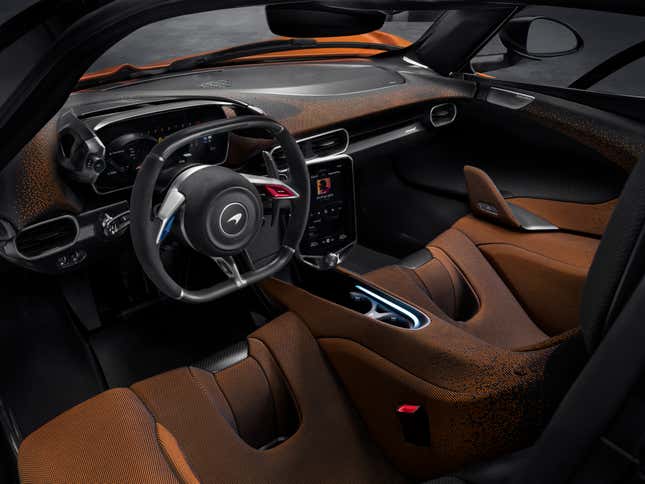
Smaller than on different McLarens, the W1’s steering wheel has a flat prime and backside and simply two buttons at your thumbs, one for the Enhance perform and the opposite for Aero Deployment, together with built-in shift lights. The digital gauge cluster doubles as a “circulate diverter” for a cool or heat stream of air from a cabin-wide subtle air vent, and there are 4 different air vents for the local weather management system, which McLaren says works properly in all drive modes. The beginning button, gear selector, Race mode management and window switches are all mounted within the roof. McLaren says the digital rear view mirror show purposefully reveals a little bit of the wing to assist with maneuvering and parking — and certainly as a result of it seems cool, too.
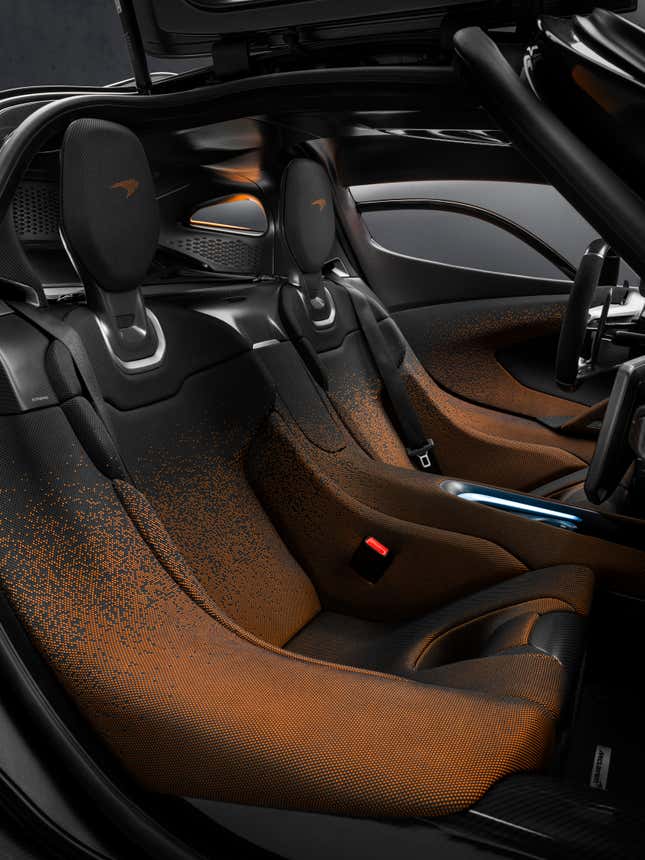
An increasing number of automakers are beginning to transfer away from protecting interiors in nothing however leather-based or suede, and the W1 debuts a brand new McLaren-developed materials known as InnoKit. Described as being “infinitely versatile and super-lightweight,” it’s knitted to suit to reduce waste from manufacturing, and it may be had with “many and a number of colours, textures and shapes with precision patterns.” The stuff seems fairly unimaginable within the orange-dominated launch spec, and it could actually diffuse and venture the ambient lighting and be used within the Bowers & Wilkins speaker grilles. After all, you’ll be able to spec your W1 with leather-based or Alcantara, each of which could be perforated for a similar audio and visible integration.
McLaren is simply making 399 of the W1, 24 items greater than the P1 however 101 fewer than the Senna, and each single one is already allotted to prospects. The beginning value is $2.1 million, nevertheless it’s extremely unlikely any will are available in at that low quantity given the “just about limitless” customization potentialities supplied by way of McLaren’s MSO bespoke division. Each W1 will include a four-year limitless mileage car guarantee and a six-year 45,000-mile battery guarantee, plus a four-year inclusive service plan.
